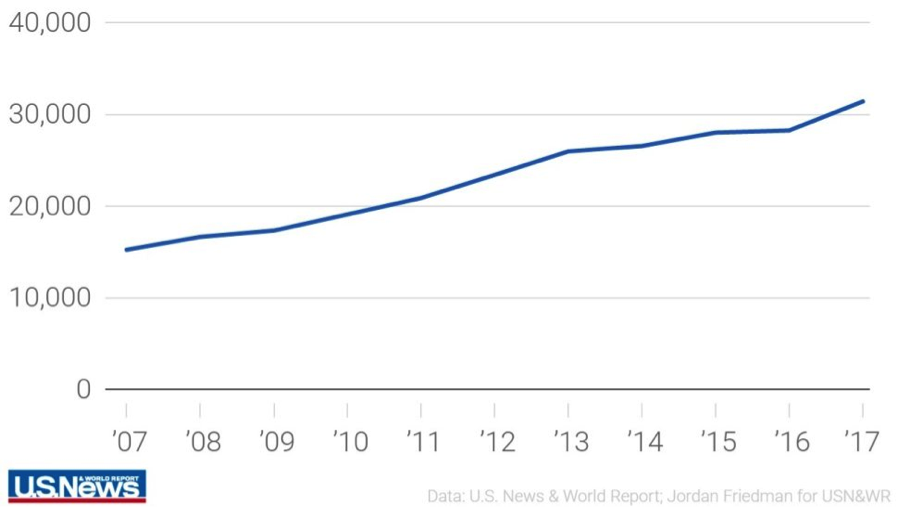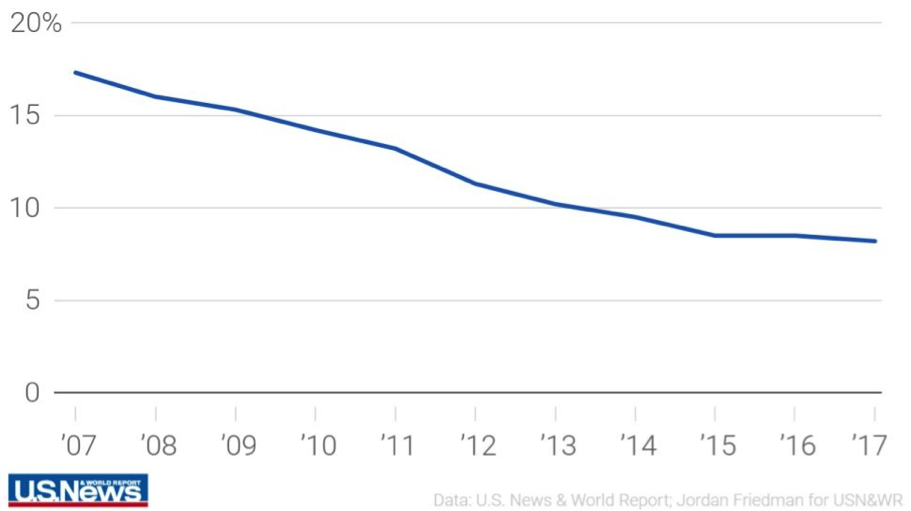Private School Admission Trends from the 2016 Cycle

A big “well done” to our students this year!
Now that most admissions results have come out (with some students still waiting to hear back from schools they’ve been waitlisted to), this would be a good time to review admission trends that we’ve noticed from this past application cycle. Overall admit rates at private schools remained around the same as last year, with a slightly lower emphasis on early applications. However, that number is not different enough that we would suggest not applying early if possible, and the benefits of applying early still vastly outweigh putting off submission of the application until the regular decision deadline. Take the University of Pennsylvania, for example. The overall admit rate for 2017 was 9.1%, while the early admit rate was more than double at 22%. Applicants to Cornell also saw a doubling of chances by applying early: the overall admit rate was 12.5%, and the early admit rate was 25.6%.
So, while admit rates this year and last remained pretty stable across most private schools that our students applied to, there were some notable changes this year in the application pool that affected the decisions turnout for students. The first is that nearly all colleges across the board saw a record number of applicants vying to get into their schools. Stanford University, for example, sifted through 44,073 student applications this year, the largest applicant pool in the school’s history. Cornell University had 47,038 applicants, nearly three thousand more than they received the previous year. This number has been creeping up every year and acceptance rates have also declined steadily, as seen below in these graphs from U.S. News:


Another noticeable trend this year has been a keenness in universities to diversify their applicant pools and student bodies by “recruiting more international, low-income and first-generation students,” says Duke University director of undergraduate admissions Christoph Guttentag. The percentages of the newly-welcomed student body allocated to each of the above has increased across all universities that we researched, in some cases more significantly than others. What does this mean for the majority of our students here in the United States? It means that they are fighting for spots in top universities against a growing sea of applicants, and that admissions sometimes isn’t as cut and dry as it has been in previous years. We have seen that factors outside of grades and test scores (although these still reign as the most important factors in admission considerations) are being taken into account.
That brings us to our next point. Another trend we’ve seen this year is that the personal profile of a student seems to be weighed more heavily than it has in the past. More schools this year have opened up the option of submitting supplemental essays or other supporting documents, and schools that already did so seem to be paying more attention to what a student has to say (as opposed to relying much more heavily on what that student has to show through grades and scores). In fact, we’ve had a few cases this year where students with not-so-stellar grades in classes, but a fantastic extracurricular profile, were admitted to the schools of their dreams. This is in line with what we’ve always told our students: build an interest in something, and come up with a compelling way to tell that story. Many students will change majors at some point in college (statistics say the average is between two to three times), but what many colleges want to see is that a student is able to become fascinated with a subject and then chase opportunities to fuel that passion. Summer programs, volunteer opportunities, college-level classes – these all remain as relevant (if not more so) than ever.
To illustrate this point we can review the case of one of our students, Ray (name changed for privacy). This student had a good GPA (not the highest, but good) and a great ACT score. However, what gave him a huge edge over his competition was his passionate dedication to telling stories through film-making. Ray was involved in many different activities that pertained to this interest: he was the director of technology at his high school’s Film Club, attended California State Summer School for the Art (CSSSA)’s program in film-making, and won second-place in a statewide contest with his film on teen suicide-prevention. Ultimately, he was accepted to nine of the twelve schools he applied for, including Duke University, John Hopkins University, Vassar College, Dartmouth College, Northwestern University, and University of California – Berkeley. His is just one case of students being successfully admitted to their dream colleges by building an interest with passion and dedication.
We expect these same trends to continue for this year’s application cycle. Most importantly, more and more students are applying to colleges every year, with only the same number of spots available to them. It is more important than ever to make sure that you stand out from the crowd – after all, after reading thousands of applications, the admissions committee is more likely to remember the student with a true heart for his or her particular interest than the student who played it safe and only stuck to activities which anyone else could have written on a resume. Grades and test scores are as important as always, as this is what make a student eligible for a college. However, pay close attention to developing interests and a consistent personal profile as well, as this is what will make a student stand out from the sea of other applicants.